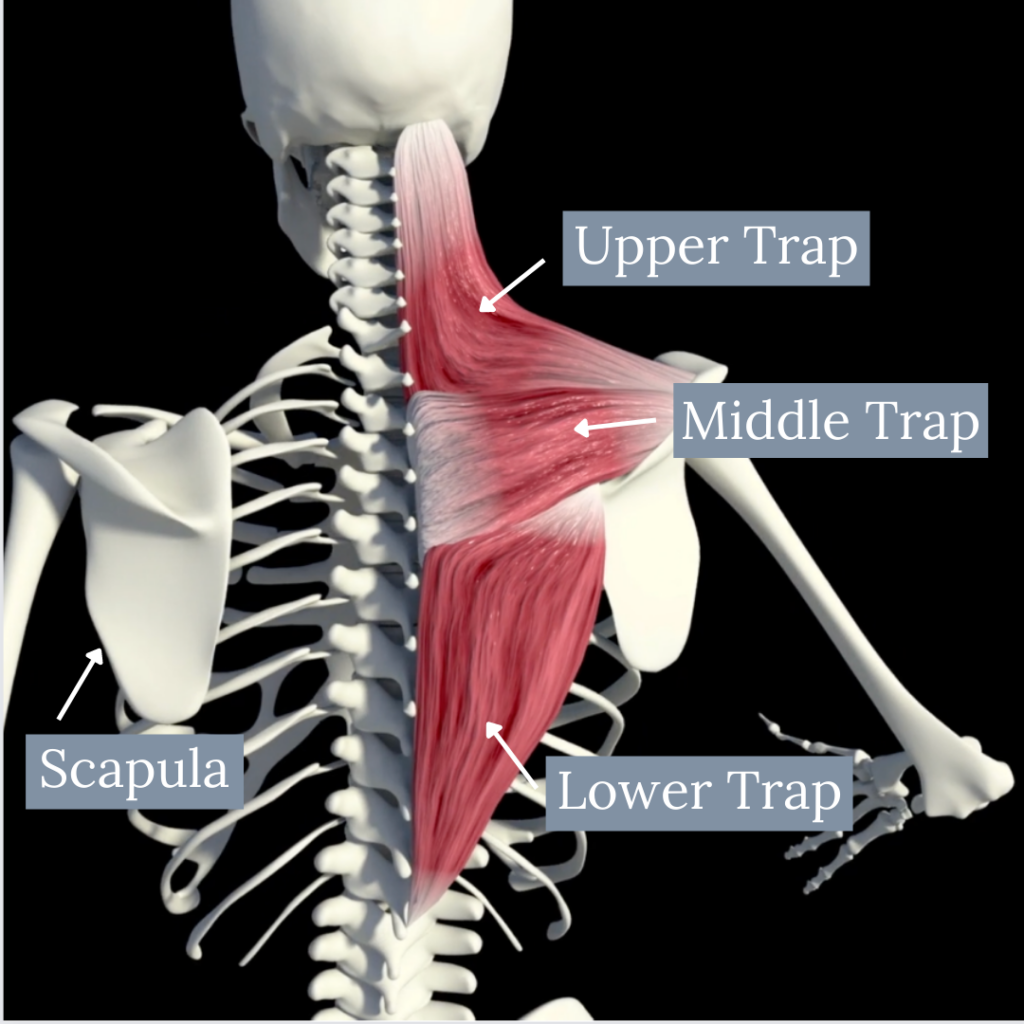
Do you catch yourself slouching, or holding tension in your shoulders? 🙋♀️ I most certainly do! It’s natural to lift your shoulders towards your ears (by engaging your upper traps) when we’re carrying something in our arms, when we’re cold, or if we’re stressed. Physiologically it makes sense: we have vital nerves and arteries that go through a thin part of our body (the neck) connecting our control center (the brain) to our pump (the heart). It’s incredibly important to protect those, so the natural response is to guard that area with our lifted shoulders.
BUT, every time we elevate our shoulders, we strengthen the upper traps and train our body to use these muscles more often. Over time the muscles that help draw the shoulder blades down and away from the ears become longer (more stretched out) and weaker, and eventually our posture starts to change.
These muscles that I keep talking about are the lower and middle trapezius muscles. These two muscles together are what help lower our shoulders away from the ears, and are vital for good/correct posture. When these muscles get weak, our chest muscles (pectoralis minor and major) tend to tighten/shorten and our head starts to lean forward (think sitting in front of a computer.)
Is this starting to sound familiar? A few blog posts ago (wall clocks) I mentioned forward head, tech neck, or text neck and how vital it was to stretch out the front side of the torso to help prevent/correct this posture. This is the other half of that equation. (Do that first then this.) As I mentioned in that other post I call this the “Marlysa.” It’s named after the physical therapist I learned it from in school – Marlysa. I haven’t seen this exercise anywhere else, otherwise, I’m sure someone would have a more common name for it by now. If you’ve done yoga therapy with me, there is a really high probability we have done this exercise. Again, I would suggest stretching the front side of the body first by doing wall clocks, or “door cactus” before doing this exercise. Because, If the front side of the body is tight/restricted/inhibited it means the back side of the body will have to work harder, or will be unable to do this drill.
Sign up for my newsletter to stay informed. Get the latest news on the latest yoga trainings, tutorials, blog posts, and discounts.
This exercise can be done standing or lying on the floor on your stomach (prone). The one thing you need is a flat surface as a guide (the wall or the floor are perfect).
Standing (you might be able to do this kneeling as well). Start by facing the wall with your nose and chest touching the wall.
Lying (because you’re working these muscles against gravity) Start by lying face down on the floor.
In either of these positions, the rest of the exercise is the same. Arms come out to the side so the elbows are in line with the shoulders, and the elbows bend at 90 degrees. Think “cactus” or “goal post” arms.
As always, if you’re a kinesthetic or auditory learner, here’s the video to go along with this post. If you’re a visual learner, feel free to read this post then try it along with the video. The video is a “follow along” so you don’t have to remember what to do, or wonder if you’re doing the drill too fast or too slow.
Keep the elbows connected to the wall or the floor and DO NOT move them. Lift your forearms and hands away from the surface (externally rotation) so your forearms and hands come away from the wall (or floor) but your elbows are still touching the surface. – Yes, this is hard! And you might not be able to lift your arms very far, and that is O.K. Over time it’ll get easier and better. I promise.
-Let’s take a pause-
You could move directly on to step two and continue with the exercise in its entirety. My preferred method, though, is to return the forearms and hands back to the wall and repeat step one a few times before moving on to the second half of the exercise. This helps to really work those lower trapezius muscles which are often the most neglected. If you follow along with the video you will be guided through this “pause” and won’t have to think “did I do that first part right?”
-Continuing on-
Keep the external rotation through the shoulders – forearms and hands off of the wall/ground and behind/above the elbows. Now lift the elbows away from the surface. This action is small – and for most people – difficult.
Again keep that external rotation (to the best of your ability) and lower the elbows back to the surface. Once the elbows touch, lower the forearms and hands back down to the ground/wall.
Like any good exercise, it works best if you do this a few times. My recommendation is to do 3 rounds of 10 per day. It doesn’t have to be all in one sitting. Honestly, doing it throughout the day is a continued reminder to activate those muscles to improve your posture as gravity takes hold during the course of the day. Added Bonus: Do step one a few extra times.
Your posture can greatly affect everything in your life: your mood, your physical appearance, and your approachability. Poor posture can lead to headaches, strained muscles, and even herniated discs. Life happens, and it often shapes how we move throughout our day and how we carry ourselves. Continually striving for good posture is a practice (just like yoga). Sign up for my weekly newsletter below to stay up to date with the latest practices to help you live the best life possible. (Including that door cactus coming up)
Sign up for my newsletter to stay informed. Get the latest news on the latest yoga trainings, tutorials, blog posts, and discounts.
(and if you’re still reading)
This exercise improves shoulder and torso mobility by strengthening the lower and middle trapezius muscles. The exercise moves the scapula/shoulder blade down the back by engaging the lower trapezius muscle through external rotation. Think standing with arms alongside your body with your arms relaxed, then turning the palms forward. That simply is external shoulder rotation.
The second part of this exercise works the middle trapezius muscle through scapular retraction (shoulder abduction). Imagine opening your arms up to give someone a great big hug. That opening of the arms is shoulder abduction and hopefully scapular retraction.
(Let’s circle it back) When these parts of the trapezius are strengthened it improves posture and helps decrease the over recruitment of the upper traps (they do shoulder/scapular elevation to draw the shoulders towards the ears) reducing the likelihood of tension headaches.

Sign up for my newsletter to stay informed. Get the latest news on the latest yoga trainings, tutorials, blog posts, and discounts.